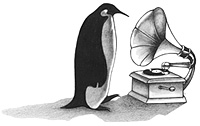| • | Familiarize yourself with proper techniques for the care and handling of magnetic tapes. |
| • | Learn and use correct procedures for operating equipment. |
| • | Handle tapes gently. |
| • | Keep tapes in protective cases when not in use. |
| • | Keep tapes vertical when not in use. |
| • | Make sure machine alignment is correct before use. |
| • | Clean tapes before use if they show any evidence of dirt or contamination.
Caution! Mold/fungus can be hazardous to your health. Wear a mask! |
| • | Ensure that the tape is properly seated in the machine before use. |
| • | Wind tape at low speed (library wind) entirely onto one reel after use. |
| • | Leave analog tapes on the take-up reel after use (tails out). |
| • | Secure tape ends on open tape reels. |
| • | Package tapes adequately for protection before shipment or transport. |
| • | Use only new tapes when recording a tape for long-term storage. |
| • | Break off or activate the record protection tab of cassettes. |
| • | Inspect tapes for damage or contamination before use. |
| • | Clean tapes before use if they show evidence of dirt or contamination. |
| • | Seek experienced help as soon as possible in the case of a disaster. |
| • | Protect both tape and machinery from dust and debris. |
| • | Keep tapes in as stable and uniform an environment as possible. |
| • | Acclimatize tapes before use if they are hot or cold. |
| • | Store tape in a cool and dry place. See ISO 18923 and AES 22-1997. |
| • | Do not touch tape surfaces with bare hands. |
| • | Do not put pressure on reel flanges. |
| • | Do not stack or place objects on top of unprotected tapes. |
| • | Do not force tapes into cases or machines. |
| • | Do not drop or throw tapes. |
| • | Do not splice any portion of a video tape. |
| • | Do not place tapes on or near sources of magnetic fields. |
| • | Do not play or spool tapes that are dirty, contaminated, or wet. |



